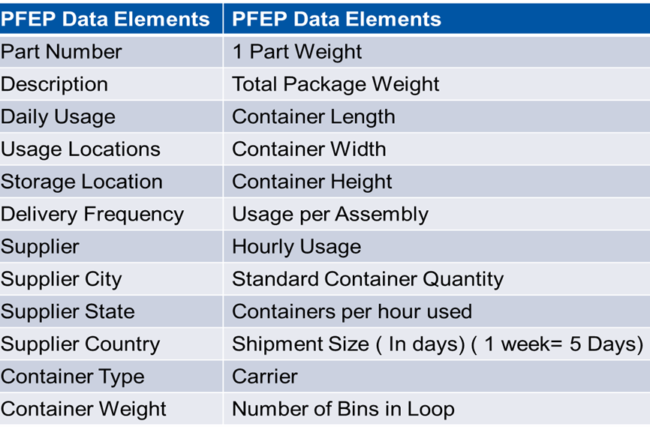Lean Manufacturing – Plan For Every Part
A Plan for Every Part (PFEP) is a material flow plan that includes specific data on every part number coming from suppliers and every finished good SKU going to a customer. This information is the baseline for making informed decisions about transportation, packaging, inventory, order quantities and delivery methodologies. PFEP tells the entire story for every part in the operation and this database is considered the DNA of the plant.

To introduce such a system, you must understand all the details about every part in your manufacturing process. How each part is purchased, received, packaged, stored, and delivered to the point of use. Accurate information regarding BOM details, meaning all information needs to be verified by the operation. Parts can be moved from station-to-station or quantities are changed on the fly for an ECN. Many times, these changes are not documented or communicated to the engineering group and the BOM is never updated. The most common problem within an organization is all this data is stored in many different places under the control of many different managers. The first step is to collect all the required parts information in one place and house these details in the PFEP. Below reference the most common categories of parts information for a PFEP.
Most facilities will start with an Excel spreadsheet and some will jump right into an Access database to load and store the PFEP data. Large facilities with many value streams should consider breaking these down by priority for gathering PFEP data. Large operations run the risk of never completing the tasks or taking short cuts that compromise the integrity of the data being entered. Smaller operations that may only have a couple of value streams could collect all the PFEP data for the entire plant.
Once you start collecting the data, try to be as granular as possible with the information being populated in each cell. Do not combine container dimensions or model usages into the same cells. Create additional columns that break out the container’s length, width, height, or separate columns for each model a line or cell runs in production. The goal is to have a document that can be sorted down to the finest element of detail for future strategic decisions. At this point in time, it is highly recommended that you assign a PFEP document manager. This person will control all the rules regarding changes and updates to the living PFEP document. This control is critical to protecting the integrity of the information going in and coming out of the database.
This is the start of creating your PFEP and the information required for a successful document. Volume 2 we will discuss how to extract data from the PFEP to make strategic decisions for inventory control, inventory levels, supermarkets, establishing standard routes, implementing pull signals and many more decisions that come from the DNA of the operation—The PFEP.
